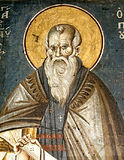 Hieromartyr Hierotheus, bishop of Athens (1st c.).
Hieromartyr Hierotheus, bishop of Athens (1st c.).  Uncovering of the relics (1595) of St. Gurias, first archbishop of Kazan, and St. Barsanuphius, bishop of Tver (1595).
Uncovering of the relics (1595) of St. Gurias, first archbishop of Kazan, and St. Barsanuphius, bishop of Tver (1595).  Synaxis of the Saints of Kazan.
Synaxis of the Saints of Kazan.
Martyrs Gaius, Faustus, Eusebius, and Chaeremon, of Alexandria (3rd c.). Hieromartyr Peter of Capitolia, bishop of Bostra in Arabia (715). Martyrs Domnina and her daughters Berenice (Bernice) and Prosdoce, of Syria (302). Martyr Adauctus (ca. 312) and his daughter St. Callisthene (ca. 318), of Ephesus. Sts. Paul the Simple (ca. 339) and Ammon (350), of Egypt, disciples of St. Anthony the Great. St. Vladimir Yaroslavich, prince of Novgorod (1052), and his mother St. Anna of Novgorod (1050). Sts. Helladius and Onesimus of the Near Caves in Kiev (12th c.-13th c.). St. Ammon, recluse, of the Far Caves in Kiev (13th c.). St. Stephen Stiljanovic, despot of Srem, Serbia (1540) and his wife St. Helen (Elizabeth in monasticism) (ca. 1543). Sts. Jonah and Nectarius, monks, of Kazan (16th c.).
New Hieromartyrs Basil (Tsvetkov), archimandrite, of Stary Kelets (Ryazan) and Tikhon Arkhangelsky, archpriest, of Kuiman (Voronezh) (1937). New Hiero-confessor Barsanuphius (Yurchenko) of Kherson (1954).
St. Theodore the Wonderworker, bishop of Tamassos, Cyprus (2nd c.). Hieromartyr Peter of Capitolia, bishop of Bostra in Arabia (715). St. John (Lampadistes) of Cyprus (10th c.). Hieromartyr Evdemoz, catholicos of Georgia (1642).
Tuesday. [Phil. 2:17-23; Luke 6:37-45]
Judge not, forgive, give… It
seems like nothing but expenses, without any profit. But
behold what is promised: if you do not condemn, you will
not be condemned; if you forgive, you will be forgiven; if
you give, you will be given to. Right now the profit is
not visible, but it will undoubtedly come for the one who
makes these expenditures from the heart—it will come
precisely at that time when he needs non-condemnation and
forgiveness the most. How he will rejoice when he is
suddenly made worthy to receive such good gifts as if for
nothing! And on the contrary, how another will sorrow and
grieve, because he did not know how to profitably manage
his property! He would now forgive everything and give
away everything, but it is too late: everything has its
time. Not everyone pursues the profit that comes directly
into one’s hands, almost right after the
expenditure. A Russian proverb says, throw bread and salt
behind you, and you will find it in front of you. This
kind of action really is like throwing something, but in
this case it is not thrown underfoot to be trampled, but
into the hands of God. These hands are true, and sure to
return what they receive. Just hold to faith and
hope.


![]() Hieromartyr Hierotheus, bishop of Athens (1st c.).
Hieromartyr Hierotheus, bishop of Athens (1st c.). ![]() Uncovering of the relics (1595) of St. Gurias, first archbishop of Kazan, and St. Barsanuphius, bishop of Tver (1595).
Uncovering of the relics (1595) of St. Gurias, first archbishop of Kazan, and St. Barsanuphius, bishop of Tver (1595). ![]() Synaxis of the Saints of Kazan.
Synaxis of the Saints of Kazan. 


















